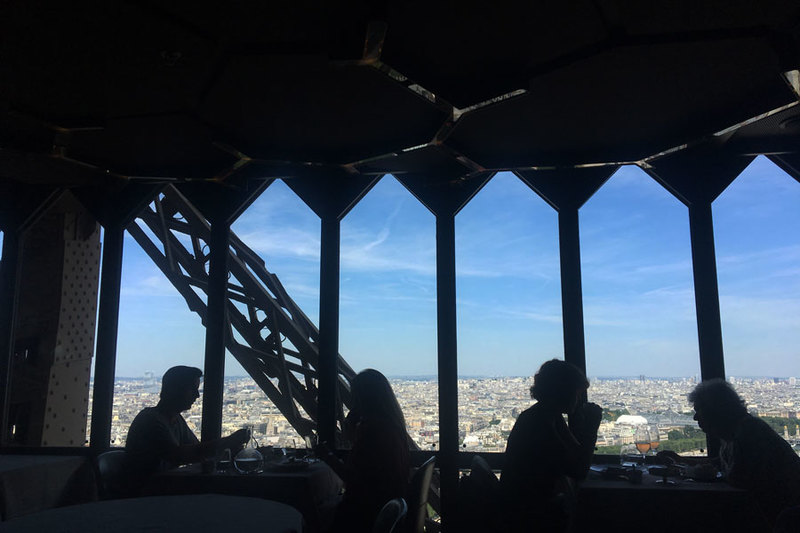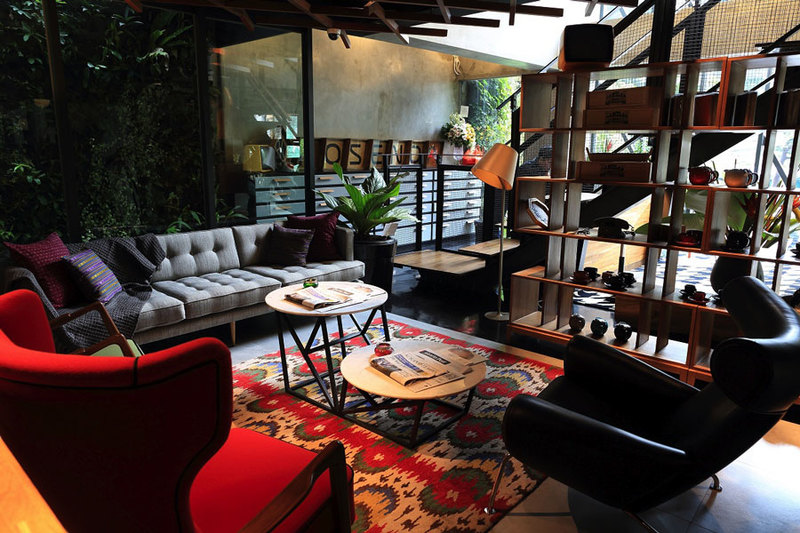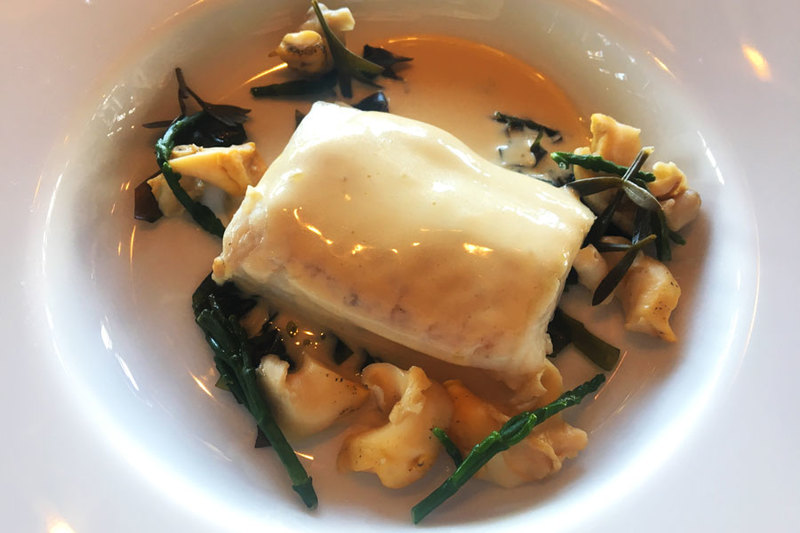When we talk about food and architecture, nothing to my mind beats Le Jules Verne restaurant at the Eiffel Tower. The reason I decided to go there was purely touristy; I wanted something to eat that was cukup bagus, with a beautiful view of Paris in the background. The view was more important to my decision than the food itself. But, there’s only so long you can stare in rapture at a view; thankfully, the food was surprisingly good, the service was excellent (they even cut up my kids’ escalopes for us), the price was relatively affordable (knowing we’d saved money on the entrance fees, and avoided the queues).

The key ingredients for any successful retail operation are location, location, location. People will pay – a lot – to experience beautiful architecture and design. But it’s often not enough to just be strategic; a great location also needs a great aesthetic. In Jakarta, for example, we have Henshin, offering up Japanese-Peruvian cuisine with breathtaking views of Jakarta from one of its tallest buildings, the Westin Jakarta. The first time I saw an advertisement for the restaurant, they used a view of the restaurant from the outside (not the view outside from the restaurant), so you could see how beautiful the design and combination of the lighting of the restaurant was. Not long after, it became the go-to place for Jakartans.
Being stylish doesn’t mean that a restaurant has to be modern – another place that I really love for my afternoon tea is Batavia Café in Kota Tua. As part of the short tour of Jakarta that we take our out-of-country guests to (after the splendours of Plaza Indonesia, Plaza Senayan, Pacific Place and PIM), I like to take my guests to Kota Tua. After a morning at the National Museum and a walk around Fatahillah Museum, nothing could be better than a rest-stop at the Batavia Café for tea, coffee and poffertjes (Holland’s great – and perhaps only? – contribution to the world’s food scene). Obviously it is interesting not just because it’s located in a historic old building, but also because of its eccentric decoration inside, which is a combination of Rick’s Bar and the back pages of the Tatler, with portraits of famous people from several decades decorating the walls and the wooden stairways. Most of all, I love to sit on the second floor, overlooking the trinket sellers, the tourists and the touts, the 1930s cycling club, and the old Dutch Fatahillah Museum. Believe me, all my guests love it.
Besides Batavia Café, another place that is famous for its design is Tugu Kunstkring Paleis, owned by the Tugu Hotels and Restaurants Group. Located in an old historical building that originally housed the Fine Arts Circle of the Dutch East Indies, the building was opened in 1914. Here you can see some of the Group’s antique collection, old paintings dominated with dusky deep reds, reflecting the history of cultural integration with the Chinese in the early 20th Century of Batavia. Surrounded by the flotsam and jetsam of history, in a building weighed down by shadows and time, you can stuff yourself with the delicious Betawi Rijsttafel, while enjoying traditional Betawi music and dancing.


But the Big Durian doesn’t just offer up history in old slices. This is a city that loves the new – even some of our “historical” buildings are new – like the Kosenda Hotel in Central Jakarta. I personally love the retro “vibe”, which at the same time feels very contemporary. The owner has really paid attention to detail, which includes the use of lots of different textured materials, from metal to wood and rattan, as well as murals that reflect the story of Jakarta and its melting pot culture. I really like the restaurant, Waha Kitchen, which mixes comfort and style, comfortable sofas and armchairs, rooms beautifully decorated with heaps of leaves and flowers, and exotic fruit and vegetables, beautifully displayed in wooden bowls. Last but by no means least (I never let ambience take away my interest in what’s being served!), they do my favourite Laksa Soup, thick and creamy and strongly flavoured with old-fashioned Indonesian herbs, kecombrang flowers.
I also love design combined with nature (and comfort of course – I don’t want the untamed outdoors – I want nature with aircon). That’s the reason why I love the Oberoi, Lombok. For a hotel in the middle of nowhere, the Oberoi offers not just a spectacularly built and maintained property but also some of the best food in Indonesia. The ingredients are fresh, much of it is sourced locally, like the fresh mahi-mahi sourced directly from passing local fishermen, to the ayam kampung for the best Soto soup I’ve had outside of my Grandma’s house. I also enjoy traditional Lombok dishes like Ayam Taliwang, which remind me of the grilled chicken of my hometown Solo, with its mix of sweet and spicy.


The best thing about being in Lombok is the fact that the view is so beautiful that anything you do, including just looking at the sea, is an entertainment in itself. Drinking a freshly squeezed lime juice in the middle of hot sunny day on the beach with that view is just heaven for me. We usually take a boat across to the Gili Islands to do some diving or snorkeling. My children love their Lombok routines – which always includes a packed lunch on the boat in the middle of the sea.
But it’s not just Indonesia that does great design and food. I’m proud to be part of ASEAN. And I’m really proud to introduce visitors, not only to Indonesia, but to the region. And what better introduction to the energy and drive of this region than Singapore.

Singapore – for me – is a city that combines the super modern with traditional Asian values of service and making you feel at home (no self-service cashiers there, thank goodness). For me, the mall at Marina Bay Sands offers that experience, in bucketfuls, and is a great example of how design is not just about great pieces of furniture, or rooms, or buildings, but also about collective spaces. Yes, I know – the mall is a temple to bling and consumerism. But it’s also home to the great ArtScience Museum, it offers stuff for kids to do, and plenty of places to eat for all budgets. I love sitting on the terrace outside, drinking a glass of cold white wine, nibbling on slices of cheese, looking at the tourists, the youngsters on hoverboards, migrant workers on their day off, couples walking hand-in-hand, grandmas and grandpas walking with their grandkids.
Great design is great for life. It makes us want to hang out together, to see and be seen, to try new things and share new experiences. Great design takes us away from our iPhones and our iPads, our GO-FOOD and pot noodles. While I’m not a person who thinks great design can make bad food good, I do think great design enhances the fun and the pleasure we take from food. At the end, we are still human beings who respond to surroundings that stimulate our senses. As my late Grandmother used to say, “Young people, go out to explore the world!”. To which I would add: “And make sure you eat, and enjoy”!
_______
This article is originally from paper. Read NOW!Jakarta Magazine March 2018 issue “Design for Living”. Available at selected bookstore or SUBSCRIBE here.







